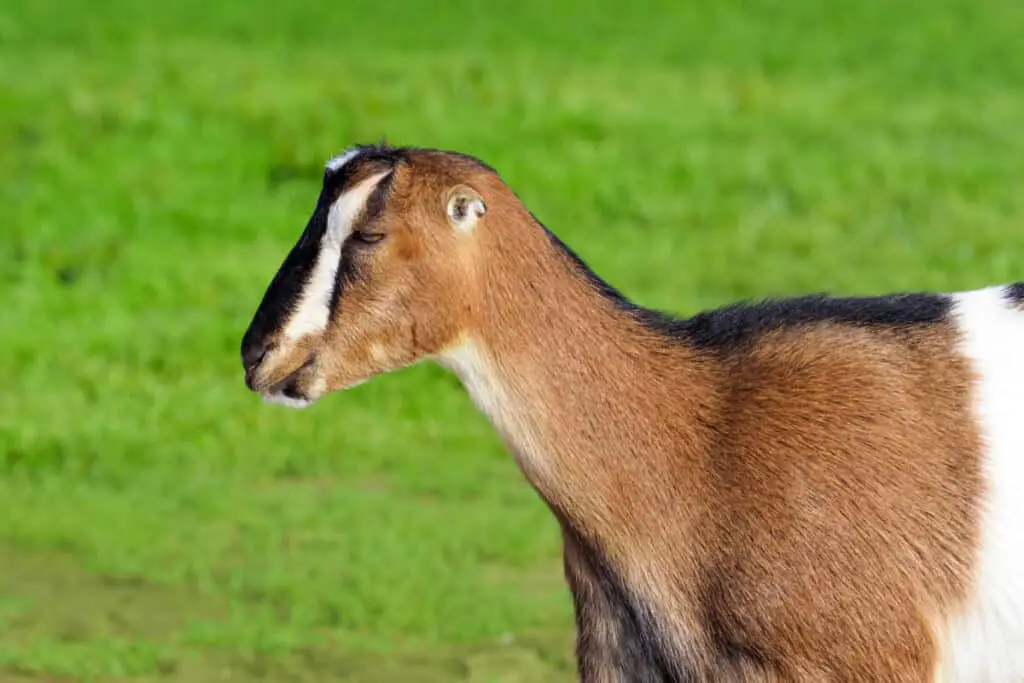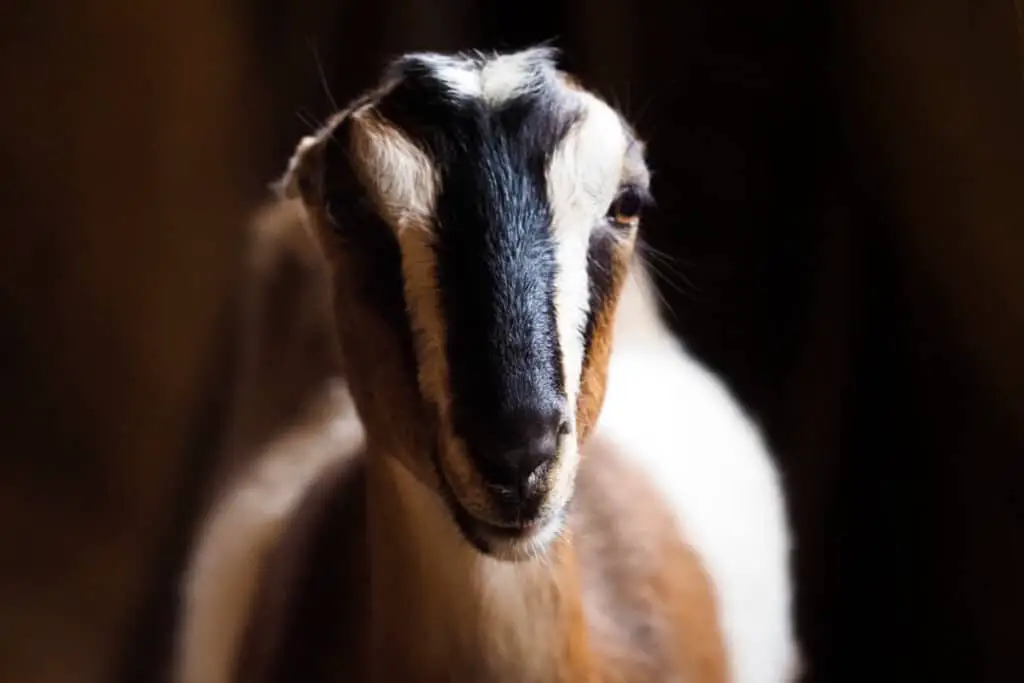The Lamancha Goat is a breed of dairy goats that originated in North America. This breed, also known as American Lamancha or simply LaMancha, is recognized for its unique physical appearance and high milk production.
The distinguishing feature of the Lamancha Goat is its small ears, which are usually only one to two inches long.
This characteristic has led to speculation about their origin, with some suggesting they were bred from goats brought over by Spanish explorers while others believe it may be a result of genetic mutation.
Despite this unusual trait, they are considered highly valuable due to their hardiness and ability to produce large quantities of milk with high butterfat content.
In this article, we will explore the history, characteristics and benefits of raising Lamancha Goats.

Origin And History Of The Lamancha Goat
The Lamancha goat is a unique breed of domestic goats that originated in the United States. It was first developed in Oregon during the 1930s through selective breeding practices by Mrs. Eula Fay Frey, who aimed to create an earless breed with high milk production.
The original herd consisted of Spanish and Swiss breeds, which were crossbred to produce animals with small ears or no external ear at all. As time passed, several other breeds such as Nubian, Toggenburg, and Alpine were added to enhance milk yield.
Due to its distinctive earlessness feature, it quickly became popular for commercial milk production among dairy farmers in the west coast region of America. Today, this breed can be found across North America and worldwide due to its excellent adaptability nature and favorable characteristics like high butterfat content in their milk.
Physical Characteristics And Unique Features
Without a doubt, the most striking feature of the Lamancha goat is its earless appearance. This unique physical trait has attracted many admirers and enthusiasts to this breed over the years. The absence of external ears in these goats makes them stand out from other breeds, making them easily recognizable wherever they go. However, it is essential to note that not all members of this breed lack ears entirely; some can have small nubs or bumps on their heads instead.
Aside from their distinctive appearance, Lamancha goats are known for their exceptional personality traits. They are friendly animals that love human interaction and enjoy being around people. They are also incredibly curious creatures who enjoy exploring new environments and experiencing new things.
Additionally, they possess an inherent intelligence that enables them to adapt quickly to different situations and learn new skills effortlessly. All these qualities make them excellent pets and companions for those looking for intelligent, sociable animals with unique looks.
Milk Production And Quality
The milk production of LaMancha goats is quite remarkable. These animals give a high yield of milk, with an average lactation period of 284 days. The daily volume ranges from 2 to 3 liters per goat, depending on various factors such as diet, age, health status, and the stage of lactation.
Moreover, LaMancha goat’s milk has excellent nutritional value as it contains higher levels of butterfat (4-6%) and protein (3-4%) than cow’s milk. It also has a lower content of cholesterol and lactose, making it suitable for people who are intolerant or allergic to these components.
Cheese making is one of the most popular uses for LaMancha goat’s milk due to its rich flavor and creamy texture. The cheese produced from this type of milk is widely appreciated by consumers worldwide. It can be used in numerous dishes like pasta, pizzas, salads, sandwiches, etc., owing to its versatility and unique taste profile.
Furthermore, cheese made from LaMancha goat’s milk tends to have higher calcium content than other types of cheese available in the market. This makes it an ideal choice for individuals concerned about maintaining bone health.
Adaptability To Different Climates And Environments
Milk production and quality are essential factors in determining the profitability of dairy goat farming. However, breeding practices also play a crucial role in enhancing milk output while maintaining high-quality standards.
The LaMancha goat breed has been selectively bred to improve its milk-producing capacity, which is reflected in their higher average daily milk yield compared to other breeds.
Moreover, genetic diversity plays an important part in ensuring that the LaMancha goats adapt well to different climates and environments. Genetic variation within a population enhances the ability of animals to resist diseases and tolerate environmental stressors such as heat or cold.
By introducing new bloodlines from other regions, farmers can maintain genetic variability, enhance breed resilience, and develop desirable traits such as increased milk production or better meat quality. Therefore, breeding programs should aim for sustainable genetic improvement by using diverse populations to meet the challenges posed by various environmental conditions.
Benefits Of Raising Lamancha Goats
Lamancha goats have become increasingly popular among farmers and breeders due to their unique characteristics and benefits. These dairy goats are known for their high milk production, docile temperament, and adaptability to various climates. They are also easy to handle and require minimal maintenance, making them an ideal choice for small farms or homesteads.
Breeding practices play a crucial role in the success of raising Lamancha goats. It is important to select healthy animals with desirable traits such as good milk production, conformation, and temperament. Breeders should also avoid inbreeding which can lead to genetic defects and poor health outcomes. Proper nutrition, regular veterinary care, and appropriate housing conditions are essential factors that contribute to the overall well-being of these animals.
Lamancha goat’s rich milk produces creamy cheese and butter.
Raising these gentle creatures brings joy and fulfillment.
Their versatile nature allows them to thrive in both rural and urban settings.
The market demand for Lamancha goat products has been steadily increasing over the years due to its superior quality compared to cow’s milk products. Goat milk contains higher levels of protein, lower lactose content, less allergenic than cow’s milk proteins thus providing great nutritional value while being easier on digestion for people who suffer from lactose intolerance. Additionally, other byproducts like soap made from goat’s milk are highly sought after due to its natural moisturizing properties that leave skin feeling refreshed.
In summary, raising Lamancha goats offer many benefits not just economically but also emotionally fulfilling. With proper breeding practices in place along with adequate care requirements met; it is possible to raise healthy animals capable of producing high-quality dairy products that meet market demands worldwide without compromising their welfare standards.
Care And Maintenance Of Lamancha Goats
As mentioned in the previous section, raising Lamancha goats can be a beneficial practice for farmers and hobbyists alike. Interestingly, these dairy goats are one of the most popular breeds in the United States, with approximately 20,000 registered annually by the American Dairy Goat Association.
To ensure that your Lamancha goats remain healthy and productive, proper care and maintenance practices must be implemented.
Grooming techniques such as regular hoof trimming and brushing help to prevent infections and keep their coats clean. In addition to grooming, feeding requirements are also crucial for optimal health. A balanced diet consisting of hay or pasture along with grain supplements should be provided based on each goat’s individual needs. It is important to monitor their water intake as well, making sure they have access to fresh water at all times.
In terms of overall care, it is recommended to establish a routine schedule for vaccinations and deworming treatments. Additionally, providing adequate shelter from extreme weather conditions and predators will promote wellbeing among your herd.
By following appropriate care and maintenance guidelines, you can ensure that your Lamancha goats thrive under your ownership while producing high-quality milk products.

Conclusion
The Lamancha goat is a unique breed of domesticated goats that originated in the United States. It was first developed in Oregon during the early 20th century by breeding Spanish and Swiss dairy goats.
The distinctive feature of this breed is its small, elf-like ears which almost seem to be nonexistent. They are known for their mild temperament and high milk production, making them popular among farmers who want an easy-to-manage herd.
Lamancha goats have adapted well to different climates and environments, making them ideal for both rural and urban farms. Their adaptability has also made it possible for the breed to thrive in various countries around the world.
Raising these goats can be very beneficial as they produce rich and creamy milk that is perfect for cheese-making or drinking raw. Moreover, they require low maintenance costs since they do not eat much, making them cost-effective for those looking to start a farm.
In conclusion, Lamancha goats offer numerous benefits such as ease-of-care, high milk productivity with quality results, adaptability to diverse climatic conditions and suitability for different types of farming environments. With all these advantages on offer at such a reasonable price point, raising these animals will undoubtedly prove fruitful whether you’re a farmer looking to expand your livestock or someone interested in starting a new hobby!
So why wait? Give it a try today!

